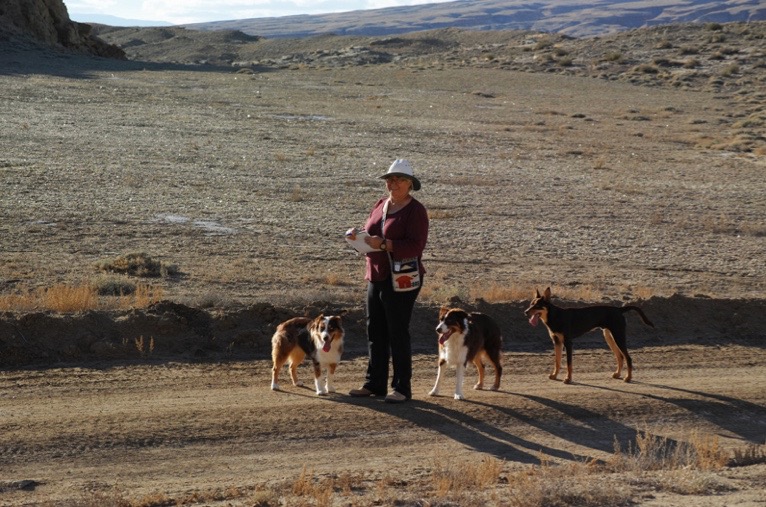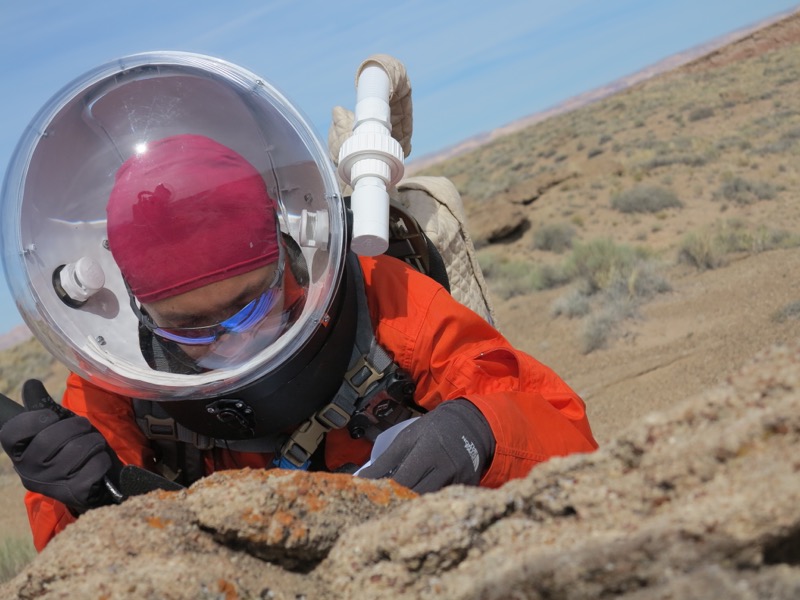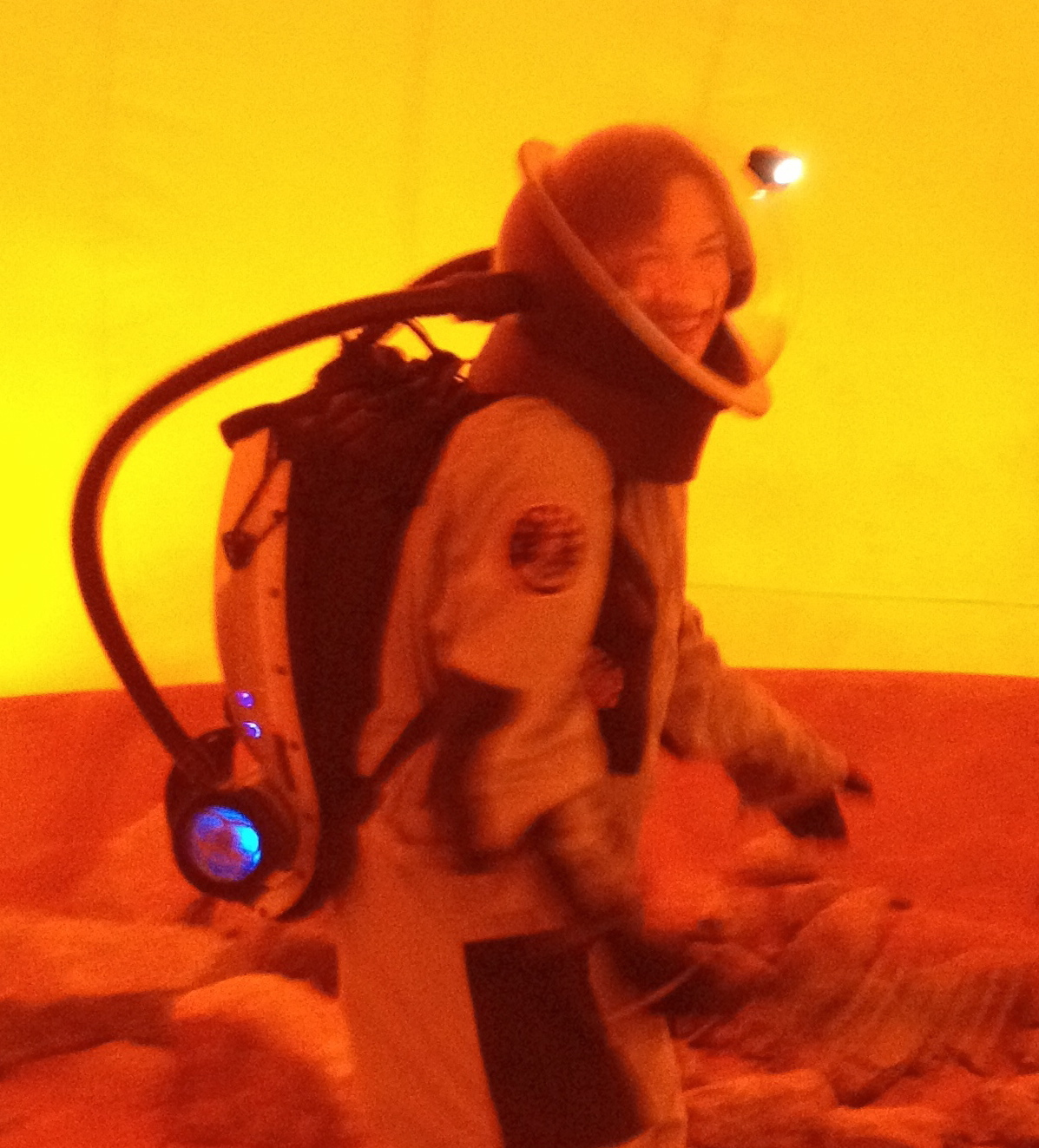Notes from Mars 160: The Science Work We're Doing

The Mars Society is conducting the ambitious two-phase Mars 160 Twin Desert-Arctic Analogue mission to study how seven crewmembers could live, work and perform science on a true mission to Mars. Mars 160 crewmember Annalea Beattie is chronicling the mission, which will spend 80 days at the Mars Desert Research Station in southern Utah desert before venturing far north to Flashline Mars Arctic Research Station on Devon Island, Canada in summer 2017. Here's her eighth dispatch from the mission:
If we find life on Mars, it will either be microbial or fossilized and living under extreme conditions. The huge diversity of microbes on Earth and their long evolutionary history make them excellent candidates for Earthly models of Martian life. For this reason, many studies of microbial life on Mars analogue sites here on Earth are focused on the extremophiles or those microbes that live in areas where conditions are extreme, in terms of temperature or chemical composition.
Mars 160 is a twin desert study in a Mars analogue setting with the goal of characterizing life in extreme environments, advancing the understanding of the limits and constraints on life and defining protocols for future successful planetary scientific exploration. On our mission, field science team members carry out field and lab work as part of a multidisciplinary crew at an analogue planetary habitat, while simulating a crew on Mars. [See more Mars 160 photos here, and get daily images by the Mars 160 crew]
This week I'd like to introduce you to our crew science team and talk about the science return as well as mention the science operations for the Mars 160 mission.
Ecologist Shannon Rupert, our Mars 160 principal investigator, coordinates the science program for the whole expedition. For her, there are two main goals for the mission.
The first is to look for life in extreme environments by examining patterns of biodiversity and distribution of organisms within geologic microhabitats here on Earth that we suspect have analogues on Mars.
Shannon told me, "Since we do not know if there was — let alone if there still is — life on Mars, our work centers on having value as Earth-based biological research, while when done in sim can also be used to determine field protocols and exploration strategies that are applicable for future planetary science missions. The lichen work we are doing for this mission is an excellent example of this, and has the added benefit of demonstrating our approach to the microbial work we are doing in a way that people can visualize and more easily understand."
Breaking space news, the latest updates on rocket launches, skywatching events and more!
The second goal is to engage a team of Earth-based experts in collaboration with the (analogue) Mars-based crew, because, while there are a limited number of scientists who will be the actual astronauts on a Mars mission, there are many scientists on Earth who could contribute to the success of the science. Shannon suggests that current thinking is that astronauts on a human mission to Mars or another planet will be science generalists, and an integrated part of science operations will be for these generalists to work in tandem with the scientists in the field and also fully participate in the collaboration done with science backrooms on Earth.
On this mission, Dr. Jon Clarke is our geologist and EVA (extravehicular activity) coordinator. He says that past environments on Earth and Mars are often different to those of the present day. Geology provides the historical perspective of changing environments over time and the context to the samples with data on soil texture, pH, salinity, geomorphic position, aspects and rock type. Without such detailed information, we will not understand many of the factors that potentially control biodiversity and distribution, both past and present. Geological data is a component to every aspect of what we will do on Mars — choosing landing sites, planning safe traverses, managing environmental hazards and locating potential resources — and also provides the basic context and many of the tools required in the search for Martian life. [The Search for Life on Mars (A Photo Timeline)]
Until physical samples from Mars can be returned to Earth, in-situ spectral analysis is the main way that scientists can examine the chemical composition of Martian rocks. Understanding what the spectroscopic signatures of Martian rocks can tell us relies on recognizing similar signatures from analogous rocks on Earth that have well-established chemical compositions and formational histories. The spectral properties of rock samples collected during both halves of Mars 160 will be analysed at the University of Arkansas under the supervision of Paul Knightly, who will join our crew in the second phase of the mission. The purpose of analyzing these samples is to better understand the connection between surface features on Mars and their analogues on Earth. Paul Knightly's own research will focus on data-logging equipment to monitor how the ground surface changes over three months.studying the patterned ground and other permafrost features near the Flashline Mars Arctic Research Station (FMARS) in the Canadian Arctic, where the second half of the Mars 160 project will take place next summer.
In terms of biology, Anushree Srivastava, our biologist, has great responsibility on our team.
As a "Mars-based" astronaut-scientist, she is working astrobiological projects that include the biodiversity of hardy lichens, the physical ecology and abundance of hypoliths, investigations of the patterns of halophilic (salt-loving) microbial diversity in the soil and the sampling of ancient evaporites of Mars analogues.
Anushree says, "We are exploring the parameters that affect the survival of organisms in the Mars-like conditions." In particular, the halophile research is the principal focus of the Mars 160 science mission. The search for microbial life on Mars is invigorated by the fact that different robotic missions to Mars corroborate the assumption that Mars was warmer and wetter in its distant past and in turn, conducive to life. Scientists have detected chloride salts or evaporate deposits on the surface of Mars using data from a variety of NASA spacecraft — the Opportunity rover, the Mars Odyssey and Mars Global Surveyor orbiters and the Mars Reconnaissance Orbiter. These data provide strong evidence of the presence of brines on ancient Mars when conditions were optimal for life. [Ancient Mars Could Have Supported Life (Video)]
Anushree is hopeful and says "since ancient Mars had an atmosphere that was more suitable for life, any microbes living in the brine might be trapped inside the fluid inclusions of evaporate deposits, potentially halite and gypsum, when the atmosphere deteriorated and salty water crystallized via evaporation. Thus, any endeavor of detection of life in the similar microhabitats of terrestrial ancient evaporates can tell us heaps about the possibility of finding salt-loving life on Mars!" Anushree is also involved in cross-training our crewmembers who perform field work during EVAs and laboratory work.
A key challenge for all our work is the fact that the science work in the field is completed in simulation. Along with the maximum science return, the goal of Mars 160 is to identify and verify the most effective operational methods to use in order to improve scientific exploration and study of a planetary surface. The end result will be to codify processes best suited to the search for life both from a scientific perspective and with collaboration between Earth-based scientists and astronauts on Mars.
Here at the Mars Desert Research Station in Utah, field and lab work is done in collaboration with a remote science team via asynchronous communication. A team located offsite is part of the simulation and identifies challenges and documents not only the science but also what is effective in terms of methodologies for future planetary exploration.
The role of Earth-based experts is to support our Mars-based crew. No other mission here at MDRS has ever had access to such a team of experts from institutions all over the world — in Canada, Spain, the U.K. and Australia, for example. Our "Earth-based" experts include Dr. Chris McKay and Dr. Kathy Bywaters of NASA's Ames Research Center in California and Paul Sokoloff from the Canadian Museum of Nature.
Geologist Paul Knightly says astronauts on Mars will ultimately make decisions on what data or samples they collect, and that is a huge responsibility to carry. Data and samples returned from a mission to Mars will be studied for decades after the mission has ended by scientists on Earth, so it is essential that the data collection objectives prior to and during the mission are made clear. Teams on Earth must also retain enough flexibility to refine objectives when taking into consideration new information gathered by astronauts in order maximize the science return of the mission. For instance, our lichen specialist, Paul Sokoloff, gives regular advice with regard to modifying lichen protocols, according to changing circumstances.
One of the aims of our mission is to address the challenges of a cross-trained crew and their ability to perform the necessary science field and lab work without being experts in that field. Shannon Rupert runs an integrated mission and believes in the power of science generalists. A generalist scientist is someone who can stand in for the expert.
Anastasiya Stepanova has been cross-trained to work with hypolith sampling, and she will work with Anushree in the new laboratory. She says that in future Mars colonization efforts, astronauts will need multiple skills. Anastasiya has a background in journalism and is studying engineering. She has never encountered field work before and says it's a great test to see how fast you can catch on to what needs to be done. Together the hypoliths science team members (including me) lay down quadrats, collect data and process samples back in the laboratory for macroscopic measurements, characterizing physical ecology, accounting for the soil, the extent of colonization and percent abundance — in particular, desert experimental sites. DNA analysis will follow. We will use the MinION instrument to identify species, telling us about the nature of the organisms themselves and what makes them adapt to their environment.
Yusuke Murakami, a geophysicist with the 50th Japanese Antarctic Expedition (2008-10), has been crossed-trained in lichens. This means he is able to scout, sample and use the tools needed from the Geophysical Survey to understand the three-dimensional context of the landscape. In terms of navigation, he takes care of safety so that Anushree is able to focus on her research. Yusuke is also trained in the protocols of laboratory work. He says, "We can't be everything by ourselves. We need three Anushrees for biology. At the same time, each person who comes to the role brings another perspective, whether they are engineer or architect or artist. There is a joy of sharing the knowledge that is productive and benefits everyone."
Shannon Rupert says that this mission is the first time she has seen the generalist and the scientist do the same job in the same site. For her, it's textbook EVA. [Gallery: The Most Memorable Spacewalks in History]
Next year, our team will spend a further 80 days in the Arctic at Flashline Mars in the Canadian summer. Though the Utah desert and the Arctic are two different extreme environments, the science objectives will be the same as here. Both are Martian analogues, so we will learn about the comparative relevance of Martian astrobiological exploration from a biological point of view and a geological point of view. At the same time, what we have learned from this phase of the mission we can apply to the next.
As for me: I'm the field artist for this expedition, and I'm testing out the relevance of geological field drawing in the spacesuit in a series of experiments that focus on how we gather data during the science EVAs. I'm thinking about the tools, techniques and strategies we use to understand the geology and the biology, as part of the science operations EVA project.
Even by the end of our first phase of this mission, I will have spent more time drawing in a spacesuit on a science field trip than anyone, alive or dead — something my mother could never have predicted. More later on this enticing topic.
On to Mars!
Annalea Beattie
Editor's Note: To follow The Mars Society's Mars 160 mission and see daily photos and updates, visit the mission's website here: http://mars160.marssociety.org/. You can also follow the mission on Twitter @MDRSUpdates. For information on joining The Mars Society, visit: http://www.marssociety.org/home/join_us/.
Annalea Beattie is an artist and writer based in Melbourne, Australia, and her art practice is based on space science. She was recently elected a director of the National Space Society of Australia. Annalea is a member of The Mars Society's Mars 160 Twin Desert-Arctic Analogue mission, where her art-based research explores how observation is key to the role of all field geologists, including those on a planetary exploration crew. Follow The Mars Society on Twitter at @TheMarsSociety and on Facebook. Original article on Space.com.








